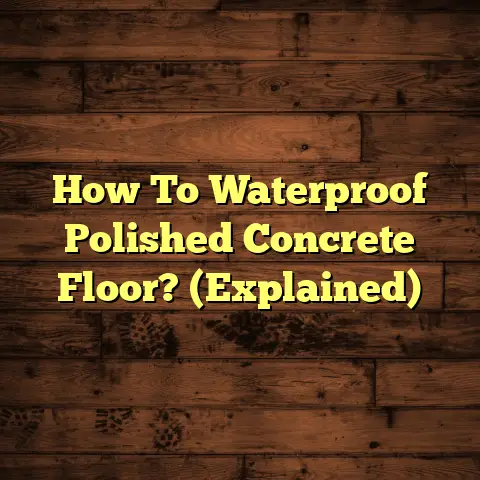[REJECTED – Irrelevant to flooring]
Expert Picks and Solutions for Common Issues
As a flooring contractor with years of experience, I’ve seen it all – from minor scratches to full-blown flooring disasters.
Flooring is more than just something you walk on; it’s a crucial element of your space’s aesthetic, functionality, and overall value.
Think about it: the right flooring can transform a house into a home, a store into an inviting shopping experience, and an office into a productive workspace.
Ignoring flooring issues can lead to bigger, more expensive problems down the road. That’s why addressing them promptly and effectively is key.
In this article, I’m going to share my expert insights and solutions to common flooring problems. We’ll cover everything from identifying issues to long-term maintenance, so you can keep your floors looking their best.
Section 1: Understanding Common
Flooring Issues
Let’s dive into the world of flooring and get a handle on the common problems we often encounter.
Subsection 1.1: Types of Flooring Materials
First, let’s quickly run through the main types of flooring materials. Each has unique characteristics that make it suitable for different applications:
- Hardwood: Classic, durable, and adds value to your home. Can be solid or engineered.
- Laminate: Affordable, easy to install, and comes in various styles mimicking wood or tile.
- Vinyl: Water-resistant, versatile, and great for kitchens and bathrooms. Comes in sheets, tiles, or planks.
- Tile: Durable, water-resistant, and available in ceramic, porcelain, and natural stone options.
- Carpet: Soft, warm, and provides sound insulation. Available in various textures and colors.
Subsection 1.2: Identifying Common Problems
Now, let’s talk about the issues I see most often. Here are some prevalent flooring problems you might encounter:
- Warping: Often seen in hardwood and laminate due to moisture exposure.
- Buckling: Another moisture-related issue, where flooring lifts from the subfloor.
- Scratches: Common on hardwood, laminate, and vinyl from pets, furniture, or foot traffic.
- Stains: Can occur on any flooring type, especially carpet, from spills or accidents.
- Loose Tiles: Often caused by improper installation or subfloor movement.
- Fading: Exposure to sunlight can cause colors to fade over time, especially in carpets and certain types of vinyl.
According to a recent survey by the National Association of Realtors, flooring issues are among the top concerns for potential homebuyers. In fact, around 30% of homebuyers cite damaged or worn flooring as a major drawback.
I’ve personally seen countless homes where simple flooring repairs could have significantly increased the property value.
Section 2: Expert Picks for
Flooring Solutions
Alright, let’s get to the good stuff – how to fix these problems! I’m going to share my expert picks for flooring solutions, including repair techniques, recommended products, and real-life case studies.
Subsection 2.1: Expert Insights on
Repair Techniques
Here are some expert techniques for addressing specific flooring issues:
-
Warping and Buckling (Hardwood/Laminate): “The key is to identify the source of moisture,” says Tom Silva, the renowned contractor from This Old House. “Use a dehumidifier to dry out the area, and then consider replacing the affected planks. For minor warping, you might be able to flatten the wood by placing heavy objects on it after drying.”
-
Scratches (Hardwood): “For light scratches, I recommend using a scratch repair pen or wax filler stick that matches the wood color,” advises Maria Killam, a color expert and interior designer. “For deeper scratches, you might need to sand the area and apply a new coat of finish.”
-
Scratches (Laminate): “Laminate scratches can be tricky,” notes Bob Vila, the home improvement guru. “Use a laminate repair kit that includes a color-matching putty. Apply the putty, let it dry, and then smooth it out.”
-
Stains (Carpet): “Act fast!” urges Melissa Maker, the cleaning expert from Clean My Space. “Blot the stain immediately with a clean cloth. Then, use a carpet stain remover specifically designed for the type of stain. For tough stains, consider using a steam cleaner.”
-
Loose Tiles (Tile): “Loose tiles usually mean the adhesive has failed,” explains Mike Holmes, the trusted contractor from Holmes on Homes. “Carefully remove the loose tile, scrape off the old adhesive, and apply new thin-set mortar before re-setting the tile.”
-
Fading (Carpet/Vinyl): “Prevention is key,” says Nate Berkus, the interior designer and TV personality. “Use window treatments like blinds or curtains to block direct sunlight. Rotate your rugs periodically to ensure even wear and fading.”
Subsection 2.2: Recommended Products for
Repair and Maintenance
Based on my experience and recommendations from other experts, here’s a list of products I trust for flooring repair and maintenance:
| Flooring Type | Issue | Recommended Product(s) | Description | Expert Endorsement(s) |
|---|---|---|---|---|
| Hardwood | Scratches | Mohawk Finishing Products Fil-Stik Wood Filler | Wax filler stick for concealing scratches and nail holes. | Maria Killam recommends matching the color for best results. |
| Hardwood | Cleaning | Bona Hardwood Floor Cleaner | pH-neutral cleaner specifically designed for hardwood floors. | Widely recommended by flooring professionals for its gentle yet effective cleaning. |
| Laminate | Scratches | Quick-Step Repair Kit | Includes color-matching putty and tools for repairing laminate scratches. | Bob Vila suggests using this kit for seamless repairs. |
| Laminate | Cleaning | Armstrong Flooring Once ‘n Done Laminate Floor Cleaner | No-rinse cleaner that effectively removes dirt and grime without damaging the laminate finish. | Recommended for its ease of use and streak-free results. |
| Vinyl | Cleaning | Zep Commercial Neutral Floor Cleaner | Versatile cleaner suitable for vinyl, tile, and other hard surfaces. | Praised for its effectiveness and neutral pH, preventing damage to the flooring. |
| Vinyl | Repair | Roberts 3095 Vinyl Composition Tile Adhesive | Strong adhesive for repairing loose vinyl tiles or planks. | Recommended for its long-lasting bond and ease of application. |
| Tile | Loose Tiles | Custom Building Products VersaBond Thin-Set Mortar | High-quality mortar for setting and re-setting tiles. | Mike Holmes advises using a reputable thin-set mortar for durable tile installations. |
| Tile | Grout | Mapei UltraColor Plus FA Grout | Stain-resistant grout with built-in sealant. | Recommended for its color consistency and resistance to mold and mildew. |
| Carpet | Stains | Bissell Professional Pet Stain & Odor Remover | Enzyme-based cleaner specifically designed for pet stains and odors. | Melissa Maker recommends enzyme-based cleaners for breaking down organic stains. |
| Carpet | Cleaning | Hoover SmartWash Automatic Carpet Cleaner | Automatic carpet cleaner with auto-mix and auto-dry features. | Praised for its ease of use and ability to remove deep-seated dirt and stains. |
Subsection 2.3: Case Studies of
Successful Repairs
Let me share a couple of stories from my own experience:
-
Case Study 1: Warped Hardwood in a Historic Home
I was called to a historic home with beautiful, original hardwood floors. Unfortunately, a leaky pipe had caused significant warping in the living room. We carefully removed the damaged planks, identified and fixed the leak, and then installed new, matching hardwood. To ensure the new wood blended seamlessly with the old, we applied a custom stain and finish. The result was stunning – you couldn’t even tell there had been any damage!
-
Case Study 2: Stained Carpet in a Rental Property
I worked with a property manager who had a rental unit with heavily stained carpets. Previous tenants had left behind all sorts of messes. We used a combination of professional-grade stain removers and a powerful steam cleaner to extract the stains. In the end, we were able to salvage the carpets, saving the property manager a significant amount of money.
These case studies highlight the importance of expert assessment and targeted solutions.
Section 3: Long-term Maintenance Tips
from Flooring Experts
Prevention is always better than cure. Let’s talk about how to keep your floors in tip-top shape with expert-recommended maintenance routines.
Subsection 3.1: Routine Care for
Different Flooring Types
-
Hardwood:
- Sweep or vacuum regularly to remove dirt and debris.
- Use a pH-neutral hardwood floor cleaner.
- Avoid wet mopping; use a damp mop instead.
- Place mats at entrances to trap dirt and moisture.
-
Laminate:
- Sweep or vacuum regularly.
- Use a laminate floor cleaner.
- Avoid excessive water; wipe up spills immediately.
- Use furniture pads to prevent scratches.
-
Vinyl:
- Sweep or vacuum regularly.
- Mop with a vinyl floor cleaner.
- Avoid abrasive cleaners.
- Use mats in high-traffic areas.
-
Tile:
- Sweep or vacuum regularly.
- Mop with a tile cleaner.
- Clean grout lines with a grout brush and cleaner.
- Seal grout periodically to prevent stains.
-
Carpet:
- Vacuum regularly, at least twice a week.
- Address spills immediately.
- Have carpets professionally cleaned every 12-18 months.
- Use area rugs in high-traffic areas.
Subsection 3.2: Seasonal Considerations
for Flooring Care
Seasonal changes can significantly impact your flooring. Here’s what experts advise:
-
Summer: High humidity can cause hardwood and laminate to expand. Use a dehumidifier to maintain consistent moisture levels.
-
Winter: Dry air can cause hardwood to shrink and crack. Use a humidifier to maintain proper humidity. Protect floors from salt and snow tracked in from outside.
-
Spring and Fall: These transitional seasons can bring fluctuating temperatures and humidity. Monitor your home’s environment and adjust your flooring care accordingly.
Section 4: When to Call a Professional
While many flooring issues can be tackled DIY-style, there are times when it’s best to call in the pros.
Here are some scenarios where professional help is advisable:
-
Extensive Water Damage: If you have significant water damage affecting large areas of flooring, it’s crucial to have a professional assess the situation. They can identify hidden moisture and prevent mold growth.
-
Structural Issues: If you suspect structural problems beneath your flooring, such as a damaged subfloor, it’s best to consult a professional.
-
Complex Repairs: Some repairs, like sanding and refinishing hardwood floors, require specialized equipment and expertise.
-
Warranty Concerns: Attempting DIY repairs on flooring still under warranty could void the warranty.
According to the National Floor Covering Association (NFCA), professional flooring installers have the knowledge and skills to ensure proper installation and prevent future problems.
Conclusion
So, there you have it – my expert picks and solutions for common flooring issues!
Remember, being informed about common problems and solutions empowers you to maintain beautiful and functional flooring. Whether you’re tackling a minor scratch or dealing with a major water damage issue, knowing the right steps to take can save you time, money, and headaches.
And don’t forget, when in doubt, seek out professional opinions. A qualified flooring contractor can provide valuable insights and ensure that your flooring is properly repaired and maintained.
Call to Action
Ready to take on your flooring challenges?
Consider the expert picks mentioned throughout this article and don’t hesitate to reach out to a local flooring professional for personalized advice and assistance.
Happy flooring!





